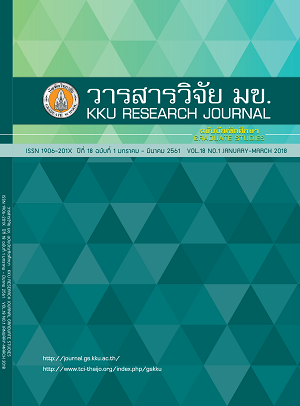การเลือกใช้ผลิตภัณฑ์เพื่อเพิ่มความขาวใสของผิวพรรณในกลุ่มนักศึกษาระดับปริญญาตรีของมหาวิทยาลัยแห่งหนึ่ง ในกรุงเทพมหานคร
Keywords:
ผลิตภัณฑ์เพื่อเพิ่มความขาวใสของผิวพรรณ (Skin whitening products), การรู้เท่าทันสื่อ (Media literacy), วัยรุ่น (Teenage)Abstract
วัยรุ่นไทยมีความนิยมการมีผิวขาวใสจากการกระตุ้นจากสื่อต่างๆ ซึ่งอาจไปสู่ปัญหาทางสุขภาพ การวิจัยนี้เพื่อประมาณผู้ที่ใช้ผลิตภัณฑ์เพื่อเพิ่มความขาวใสของผิวพรรณ และหาปัจจัยในการใช้ผลิตภัณฑ์ดังกล่าวของนักศึกษาระดับปริญญาตรี การสำรวจโดยให้กลุ่มตัวอย่าง จำนวน 319 คนตอบแบบสอบถามด้วยตนเอง ผลการวิจัย พบว่า กลุ่มตัวอย่างร้อยละ 20 บริโภคผลิตภัณฑ์เพื่อเพิ่มความขาวใสของผิวพรรณ การวิเคราะห์ด้วยสถิติถดถอยแบบโลจิสติค พบว่า ปัจจัยที่มีความสัมพันธ์ต่อการตัดสินใจใช้ผลิตภัณฑ์ ได้แก่ การไม่พึงพอใจต่อผิวพรรณของตนเอง ความรู้ในเรื่องของผลิตภัณฑ์เสริมเพื่อเพิ่มความขาวใสของผิวพรรณ การได้รับคำปรึกษาจากบุคลากรทางการแพทย์ และผู้ที่มีรายได้ต่อเดือนมากกว่า 10,000 บาทขึ้นไป ผลการวิจัยนี้นำไปสู่การให้ความรู้และสร้างการสื่อสารเกี่ยวกับการบริโภคผลิตภัณฑ์เพื่อเพิ่มความขาวใส
The presumed influence of the lightening skin from media may lead to the adverse effects. The aims of this study were to estimate the rate of skin lightening consumer among undergraduate student and the factors affected on their decision. The total 319 participant were included into the study, 20% of them using skin lightening products during past 3 months. The multiple logistics regression showed that self-image of darker skin, knowledge about products, social support from health staff and monthly income were associated to decision making for consuming skin lightening products. Creating risk communication and health literacy about skin lightening products need to be developed.
References
2. Witthayakorn C. Adolescent psychology. Bangkok: Winyuchon; 2009. Thai.
3. Thitikan P, Phansapon K. The Behaviors of consuming supplementary food of students Kamphaeng Phet Rajabhat University MaeSot. In: Naresuan 12th researches and innovation for development 2016 July 21-22; Naresuan University, Thailand. Pitsanulok: 2016. p. 1439-1451. Thai.
4. Varawan J. Factor related to people’s behavior on dietary supplement products in Bangkok metropolitan [Thesis]. Banngkok: Kasetsart University; 2001. Thai.
5. Ornautjima P, Sawaros S. Comparison of behavior and attitude towards marketing factors to buy supplements of youth, adult, middle aged and elderly [Master of Business Administration]. Bangkok: University of the Thai Chamber of Commerce; In press. Thai.
6. Martin P., Skin whitening big market in Asia; 2009 [cited 2017 Jul 25]. Available from: https://www.pri.org/stories/2009-03-30/skin-whitening-big-business-asia.
7. Kanitta K. Marketing mix factors affecting buying behavior supplement containing glutathione of teenagers in Bangkok [Dissertation]. Petchaburi: Silpakorn University; 2015. Thai.
8. Thaksinee S, Benjamaporn K, Suttasinee S, Narongchai C, Suwanna P. The use of glutathione for whitening skin among UbonRatchathani University students according to the theory of planned behavior. IJPS 2016; 11: 171-178. Thai.
9. Sutineekorn P. Factors affecting the decision towards selecting beauty clinic of students in Bangkok area [Independent study]. Bangkok: Kasetsart University; 2015. Thai.
10. Sakesan W, Warangkana A. The study of consumer behavior on vitamin supplement products in Bangkok. Srinakharinwirot business journal 2014; 1: 65-79. Thai.
11. Fleiss JL. Statistical Methods for Rates and Proportions. 2nd Ed. New York: Wiley; 1981.
12. Mikirova N, Casciari J, Riordan N, Hunninghake R. Clinical experience with intravenous administration of ascorbic acid: achievable levels in blood for different of inflammation and disease in cancer patients. Journal of Translational Medicine 2013; 11: 191
13. Mikirova NA, Ichim TE, Riordan NH. Anti-angiogenic effect of high doses of ascorbic acid. Journal of Translational Medicine 2008; 6: 50
14. Stephenson CM, Levin RD, Spector T, Lis CG. Phase I clinical trial to evaluate the safety, tolerability and pharmacokainetics of high-dose intravenous ascorbic acid in patients with advanced cancer. Cancer Chemotherapy and Pharmacology 2013; 72: 139-146
15. Hamann CR, Boonchai W, Wen L, Sakanashi EN, Chu CY, Hamann K, Hamann CP, Sinniah K, Hamann D. Spectrometric analysis of mercury content in 549 skin-lightening products: Is mercury toxicity a hidden global health hazard?. Journal of the American Academy of Dermatology. 2014 Feb 28; 70(2): 281-287.
16. Kamagaju L, Morandini R, Gahongayire F, Stévigny C, Ghanem G, Pirotte G, Duez P. Survey on skin‐lightening practices and cosmetics in Kigali, Rwanda. International journal of dermatology. 2016 Jan 1; 55(1): 45-51.
17. Peltzer K, Pengpid S. Knowledge about, attitude toward, and practice of skin lightening products use and its social correlates among university students in five Association of Southeast Asian Nations (ASEAN) countries. International journal of dermatology. 2017 Mar 1; 56(3): 277-283.
18. Wong C, Wong S, Tang H, Minocha R, Singh R, Grills N. Use of skin-lightening products among outpatient attendees in a North Indian Hospital. Indian Journal of Public Health. 2017 Apr 1; 61(2): 137.
19. Dlova NC, Hamed SH, Tsoka‐Gwegweni J, Grobler A. Skin lightening practices: an epidemiological study of South African women of African and Indian ancestries. British Journal of Dermatology. 2015 Jul 1; 173(S2): 2-9.
20. Alter AL, Stern C, Granot Y, Balcetis E. The “bad is black” effect: Why people believe evildoers have darker skin than do-gooders. Personality and Social Psychology Bulletin. 2016 Dec; 42(12): 1653-1665.
21. Malathi M, Thappa DM. Systemic skin whitening/lightening agents: What is the evidence?. Indian Journal of Dermatology, Venereology, and Leprology. 2013 Nov 1; 79(6): 842.
22. Lakkana A, Pranee L, Pannee P. Consumer behaviors and knowledge about supplementary products in Northeastern, Thailand. Alternative Medicine Bureau 2008; Initial period: 37-45. Thai.



